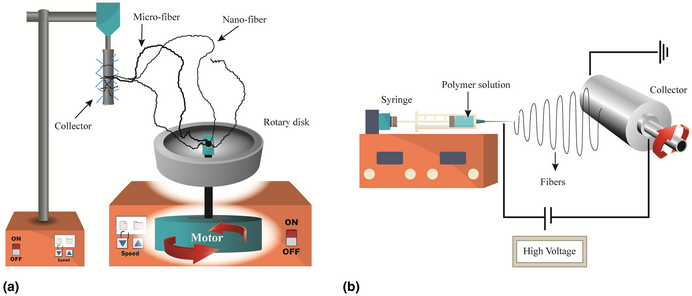Crossref Citations
This article has been cited by the following publications. This list is generated based on data provided by
Crossref.
Banerji, Aditya
Jin, Kailong
Mahanthappa, Mahesh K.
Bates, Frank S.
and
Ellison, Christopher J.
2021.
Porous Fibers Templated by Melt Blowing Cocontinuous Immiscible Polymer Blends.
ACS Macro Letters,
Vol. 10,
Issue. 10,
p.
1196.
Gradinaru, Luiza Madalina
Bercea, Maria
Vlad, Stelian
Barbalata Mandru, Mihaela
Drobota, Mioara
Aflori, Magdalena
and
Ciobanu, Romeo Cristian
2022.
Preparation and characterization of electrospun magnetic poly(ether urethane) nanocomposite mats: Relationships between the viscosity of the polymer solutions and the electrospinning ability.
Polymer,
Vol. 256,
Issue. ,
p.
125186.
Bahú, Juliana O.
Melo de Andrade, Lucas R.
Crivellin, Sara
Khouri, Nadia G.
Sousa, Sara O.
Fernandes, Luiza M. I.
Souza, Samuel D. A.
Concha, Luz S. Cárdenas
Schiavon, Maria I. R. B.
Benites, Cibelem I.
Severino, Patrícia
Souto, Eliana B.
and
Concha, Viktor O. Cárdenas
2022.
Rotary Jet Spinning (RJS): A Key Process to Produce Biopolymeric Wound Dressings.
Pharmaceutics,
Vol. 14,
Issue. 11,
p.
2500.
Toniciolli Rigueto, Cesar Vinicius
Rosseto, Marieli
Alessandretti, Ingridy
de Oliveira, Rafaela
Wohlmuth, Daniela Alexia Raber
Ferreira Menezes, Juliana
Loss, Raquel Aparecida
Dettmer, Aline
and
Pizzutti, Ionara Regina
2022.
Gelatin films from wastes: A review of production, characterization, and application trends in food preservation and agriculture.
Food Research International,
Vol. 162,
Issue. ,
p.
112114.
Cai, Jiaonan
Liu, Shenghui
Gao, Chunmei
Ji, Shifeng
and
Xing, Yunqing
2023.
A high-toughness anti-pollution polyethersulfone membrane for efficient separation of oil-in-water emulsions.
Journal of Environmental Chemical Engineering,
Vol. 11,
Issue. 1,
p.
108980.
Venkataraman, Dhanya
Shabani, Elnaz
Joshi, Kartik
Widjaja, Olivia
and
Park, Jay Hoon
2023.
Comparative Investigation of Electrospun and Centrifugal Spun Polylactic Acid for Filtration Performance and Reusability.
ACS Applied Engineering Materials,
Vol. 1,
Issue. 8,
p.
2315.
Larsen, Gustavo
Gonzalez, Daniela
Noriega, Sandra
and
Ragusa, Jorge
2023.
Favoring needleless electrospinning and electrospray over flow-through-orifice approaches for making ultrafine fibers and particles: a mini-review.
Chemical Engineering Communications,
Vol. 210,
Issue. 12,
p.
2249.
Bortolotto Degregori, Emanuelle
Corbellini Henckes, Nicole Andrea
Franco, Nathalia
Luz, Henrique
Maurmann, Natasha
Viana, Altevir Rossato
Rohden, Francieli
Loureiro dos Santos, Luis Alberto
Cirne Lima, Elizabeth Obino
Terraciano, Paula Barros
Oliveira, Fernanda dos Santos
and
Contesini, Emerson Antonio
2023.
Interaction between adipoderivated mesenchymal stem cells and PLGA/PIepox scaffold with possible use in tissue engineering: in vitro study.
International Journal of Polymeric Materials and Polymeric Biomaterials,
Vol. 72,
Issue. 14,
p.
1132.
Zannini Luz, Henrique
and
Loureiro dos Santos, Luís Alberto
2023.
Centrifugal spinning for biomedical use: a review.
Critical Reviews in Solid State and Materials Sciences,
Vol. 48,
Issue. 4,
p.
519.
Biliuta, Gabriela
Zhang, Sufeng
Gradinaru, Luiza Madalina
Bercea, Maria
Baron, Raluca Ioana
Bejan, Dana
and
Coseri, Sergiu
2024.
Advanced pullulan nanofibers reinforced by cellulose fibrils as drug carriers for salicylic acid.
International Journal of Biological Macromolecules,
Vol. 283,
Issue. ,
p.
137624.
Naseri Joda, Nasrollah
Ince, Ahmet Erdem
Rihova, Martina
Pavlinak, David
and
Macak, Jan M
2024.
Design of collectors in centrifugal spinning: Effect on the fiber yield and morphology.
Journal of Industrial Textiles,
Vol. 54,
Issue. ,




